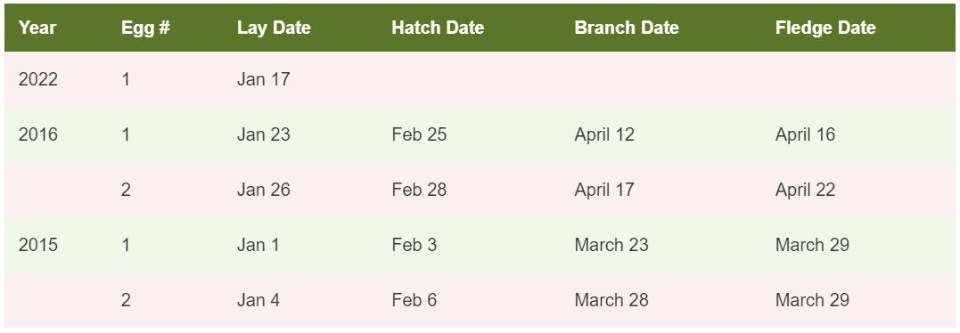Tā kā otrā oliņa “nenāk” pameklēju vēl info par to vai vēl vispār ir cerības gaidīt…
Do They Mate For Life?
Great Horned Owls are monogamous and members of a pair often remain on the same territory year round. Pairs may stay together for at least five years, perhaps for life. If something happens to one of the pair, the survivor will usually find another mate.
How Many Eggs Do Great Horned Owls Lay?
Clutch size ranges from one to four eggs, very rarely five, with two being the most common.
When Were The Eggs Laid?
The owls nesting at the cam site on Skidaway Islands have started the egg-laying process in January. See the Great Horned Owl cam timeline for a full overview of the owls’ nesting history at this site. Great Horned Owls generally only have one brood per season. Replacement clutches are possible if the eggs are taken or destroyed during incubation. The timing of laying varies with latitude. In lower latitude states, such as Florida, incubation can begin in late November. In the Carolinas, eggs are laid from late December to early January. One egg is usually laid every two days, but there can be an interval of up to one week between laying.
How Long Does It Take For The Eggs To Hatch?
Incubation begins after the first egg is laid, so young hatch over a period of several days. According to the scientific literature, Great Horned Owls usually incubate their eggs for about 30—37 days.
How Big Are The Eggs?
Generally the first egg is the largest and the last is smallest. Eggs in the eastern U.S. and Laborador, averaged 2.2 by 1.8 inches (5.6 by 4.7 centimeters); in California, 2.1 by 1.8 inches (5.3 by 4.5 centimeters). In Los Angeles County, California, mean mass was 1.8 ounces (51.3 grams), about 3.3 percent of the female’s body mass.
No One Is Sitting On The Eggs Or Young. Won’t They Get Cold?
It is normal for parents to leave the eggs and nestlings exposed now and then. In most cases, they don’t stay away long enough for the eggs or young to suffer harm. Great Horned Owls have evolved over millions of years to cope with variable conditions, including harsh weather. The owls are able to incubate eggs successfully when outside temperatures are below -27.4 degrees Fahrenheit (-33 degrees Centigrade). Eggs have been recorded to withstand female absence of 20 minutes at -13 degrees Fahrenheit (-25 degrees Centigrade) when the female joined her mate in hooting at a neighboring male.
https://www.allaboutbirds.org/news/bird ... ggs-number
Vai viņi paliek pārī uz mūžu?
Amerikas ūpji ir monogāmi, pāris bieži uzturas vienā teritorijā visu gadu. Pāri var palikt kopā vismaz piecus gadus, iespējams uz visu mūžu. Ja kaut kas notiek ar kādu no pāra, izdzīvojušais parasti atrod citu dzīvesbiedru.
Cik olu dēj amerikas ūpji?
Dējums svārstās no vienas līdz četrām olām, ļoti reti piecām, bet visbiežāk ir divas.
Kad tika dētas olas?
.. Amerikas ūpjiem sezonā parasti ir tikai viens perējums. Otrais perējums ir iespējams, ja olas tiek atņemtas vai iznīcinātas inkubācijas laikā. .. Ola parasti tiek izdēta ik pēc divām dienām, taču starp dēšanu var būt pat viena nedēļa.
Cik ilgs laiks nepieciešams, lai olas izšķiltos?
Inkubācija sākas pēc pirmās olas izdēšanas, tāpēc mazuļi izšķiļas vairāku dienu laikā. Saskaņā ar zinātnisko literatūru amerikas ūpji parasti inkubē olas apmēram 30–37 dienas.
Cik lielas ir olas?
Parasti pirmā ola ir lielākā, bet pēdējā ir mazākā. Olas ASV austrumos un Labradorā ir vidēji 2,2 x 1,8 collas (5,6 x 4,7 centimetri); Kalifornijā, 2,1 x 1,8 collas (5,3 x 4,5 centimetri). Losandželosas apgabalā, Kalifornijā, vidējā masa bija 1,8 unces (51,3 grami), kas ir aptuveni 3,3 procenti no sievietes ķermeņa masas.
Neviens nesēž uz olām, vai tās nenosals?
Ir normāli, ka vecāki šad un tad atstāj atklātas olas un ligzdu. Vairumā gadījumu olas un mazuļi tiek atstāti tik ilgi, lai tiem nenodarītu kaitējumu. Amerikas ūpji ir attīstījušies miljoniem gadu, lai tiktu galā ar mainīgiem apstākļiem, tostarp skarbajiem laikapstākļiem. Ūpji spēj veiksmīgi inkubēt olas, ja āra temperatūra ir zemāka par -27,4 grādiem pēc Fārenheita (-33 grādiem pēc Celsija). Ir reģistrēts, ka olas iztur mātītes prombūtni 20 minūtes pie -13 grādiem pēc Fārenheita (-25 grādiem pēc Celsija), kad mātīte pievienojās savam dzīvesbiedram, cīņā pret kaimiņu tēviņu.
Olu dēšanas vēsture:
 https://www.allaboutbirds.org/cams/grea ... -timeline/
https://www.allaboutbirds.org/cams/grea ... -timeline/
Šķiet otro oliņu jau droši var negaidīt .






